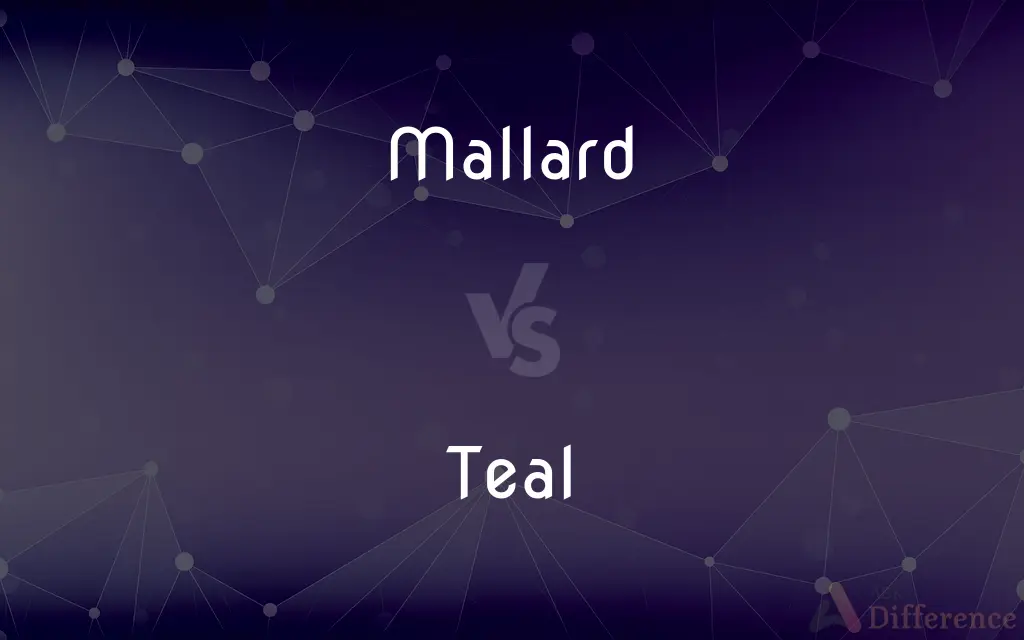Mallard vs. Teal — What's the Difference?
Edited by Tayyaba Rehman — By Fiza Rafique — Updated on April 8, 2024
Mallards are larger, dabbling ducks with distinctive male plumage, while teals are smaller, with quicker flight patterns and often more colorful wing patterns.

Difference Between Mallard and Teal
Table of Contents
ADVERTISEMENT
Key Differences
Mallards are a common species of wild duck known for their distinctive green heads in males and mottled brown plumage in females. They are larger ducks, typically found in a wide range of habitats including ponds, lakes, and rivers across North America, Europe, and Asia. Mallards are dabbling ducks, feeding on the water's surface or tipping forward to reach underwater plants and animals. Their flight is powerful and direct, with noticeable wingbeats.
Teals belong to a smaller group of ducks, characterized by their small size and swift flight. Males often display strikingly colorful wing patterns, especially noticeable during flight. Teals are found in a variety of habitats, including marshes and shallow ponds, and they have a more global distribution, including areas in Europe, Asia, Africa, and the Americas. Like mallards, teals are also dabbling ducks but they tend to forage in shallower waters. Their flight is rapid and agile, often executed in tight flocks, which contrasts with the more solitary or pair-based flight of mallards.
In terms of behavior, mallards are adaptable and can often be found in urban and suburban areas, becoming accustomed to human presence. They have a varied diet, eating plants, seeds, insects, and small fish. Teals, while also adaptable, are more often found in wilder, less disturbed habitats. They have similar diets but due to their smaller size, they may focus more on smaller prey and seeds.
Breeding differences are also notable. Mallards are known for their elaborate mating displays and are often monogamous for a breeding season. Teals, though also forming breeding pairs, have less conspicuous courtship behaviors and tend to nest in more concealed locations.
The conservation status of mallards is generally of less concern due to their wide distribution and adaptability. However, some teal species, due to specific habitat requirements, may face threats from habitat destruction and are closely monitored by conservationists.
ADVERTISEMENT
Comparison Chart
Size
Larger, more robust
Smaller, more compact
Flight
Powerful, direct, with noticeable wingbeats
Rapid, agile, often in tight flocks
Male Plumage
Distinctive green head (in males)
Colorful wing patterns (in males)
Habitat
Wide range, including urban areas
Prefer wilder, less disturbed habitats
Diet
Varied, including plants, seeds, insects
Similar, but may focus more on smaller prey
Breeding
Elaborate mating displays, monogamous
Less conspicuous courtship, more concealed
Conservation
Generally less concern
Some species closely monitored
Compare with Definitions
Mallard
Adaptable to various habitats.
Mallards thrive both in rural ponds and urban parks.
Teal
Prefers shallower, less disturbed waters.
Teals are commonly found in secluded marshes.
Mallard
Less concerned by conservation efforts.
The widespread mallard faces few threats compared to other species.
Teal
A small, swift-flying duck with colorful wing patterns.
The teal's quick flight is mesmerizing to watch.
Mallard
Engages in notable mating displays.
Mallard males perform elaborate dances to attract females.
Teal
Also a dabbling duck, focusing on smaller prey.
Teals dabble in very shallow waters for their meals.
Mallard
Dabbling duck feeding on the water's surface.
Mallards are often seen tipping forward to feed in shallow waters.
Teal
Some species are of conservation interest.
The habitat preferences of teals require careful monitoring.
Mallard
A common, large wild duck with a green head in males.
The mallard drake's vibrant green head makes it easily recognizable.
Teal
Less conspicuous in courtship behaviors.
Teal pairs form quietly without much display.
Mallard
The mallard () or wild duck (Anas platyrhynchos) is a dabbling duck that breeds throughout the temperate and subtropical Americas, Eurasia, and North Africa, and has been introduced to New Zealand, Australia, Peru, Brazil, Uruguay, Argentina, Chile, Colombia, the Falkland Islands, and South Africa. This duck belongs to the subfamily Anatinae of the waterfowl family Anatidae.
Teal
Teal is a cyan-green color. Its name comes from that of a bird — the Eurasian teal (Anas crecca) — which presents a similarly colored stripe on its head.
Mallard
A wild duck (Anas platyrhynchos) found almost worldwide, the male of which has a green head and neck. Most domestic ducks descend from the mallard.
Teal
Any of several small dabbling ducks, chiefly of the genus Anas, often having brightly marked plumage.
Mallard
Anas platyrhynchos, a common and widespread dabbling duck, natively found throughout the Northern Hemisphere, whose male has a distinctive dark green head.
Teal
A moderate or dark bluish green to greenish blue.
Mallard
A drake; the male of Anas boschas.
Teal
(countable) Any of various small freshwater ducks of the genus Anas that are brightly coloured and have short necks.
Mallard
A large wild duck (Anas boschas) inhabiting both America and Europe. The domestic duck has descended from this species. Called also greenhead.
Teal
A dark, somewhat bluish-green colour; a dark cyan.
Mallard
Wild dabbling duck from which domestic ducks are descended; widely distributed
Teal
A politician who espouses environmentally and socially progressive but economically conservative ideas, especially in the context of a group of independent candidates who ran in the 2022 federal election.
Teal
Having a bluish-green colour
Teal
Any one of several species of small fresh-water ducks of the genus Anas and the subgenera Querquedula and Nettion. The male is handsomely colored, and has a bright green or blue speculum on the wings.
Teal
A shade of green tinged with blue;
They painted it a light shade of bluish green
Teal
Any of various small short-necked dabbling river ducks of Europe and America
Teal
A bluish shade of green
Common Curiosities
How do mallards and teals differ in size?
Mallards are larger and more robust, while teals are smaller and more compact.
Can you find mallards in urban areas?
Yes, mallards are adaptable and can commonly be found in both urban and suburban settings.
How do mallard and teal diets compare?
Both have varied diets including plants, seeds, and insects, but teals may focus more on smaller prey due to their size.
What makes teal flight patterns unique?
Teals fly rapidly and agilely, often in tight flocks, contrasting with the more solitary or pair-based flight of mallards.
Are teals found in urban areas like mallards?
Teals are less commonly found in urban areas, preferring more natural, secluded water bodies.
What is a teal?
A teal is a small, swift-flying duck, noted for its colorful wing patterns and preference for shallower waters.
Why are some teal species closely monitored by conservationists?
Due to specific habitat requirements and threats from habitat destruction, some teal species are of conservation interest.
What is a mallard?
A mallard is a common species of wild duck, known for the male's distinctive green head and adaptable nature.
Are both mallards and teals dabbling ducks?
Yes, both are considered dabbling ducks, feeding on the water's surface or tipping forward to reach food.
What are the breeding habits of mallards?
Mallards engage in elaborate mating displays and are often monogamous for a breeding season.
What is the conservation status of mallards?
Mallards are generally of less conservation concern due to their widespread distribution and adaptability.
Can the teal's flight be distinguished from that of the mallard?
Yes, the teal's flight is notably quicker and more agile, often executed in tight flocks, unlike the mallard's more powerful and direct flight.
Do mallards and teals have similar feeding behaviors?
Yes, both species exhibit dabbling behavior but may differ in the specifics of their diets and feeding areas.
How do the habitats of mallards and teals differ?
While mallards adapt to a wide range of habitats, including urban areas, teals prefer wilder, less disturbed habitats.
Are there significant differences in the courtship behaviors of mallards and teals?
Yes, mallards are known for their more elaborate mating displays, while teals tend to form pairs with less conspicuous behaviors.
Share Your Discovery

Previous Comparison
Plateau vs. Highland
Next Comparison
Mythos vs. MythologyAuthor Spotlight
Written by
Fiza RafiqueFiza Rafique is a skilled content writer at AskDifference.com, where she meticulously refines and enhances written pieces. Drawing from her vast editorial expertise, Fiza ensures clarity, accuracy, and precision in every article. Passionate about language, she continually seeks to elevate the quality of content for readers worldwide.
Edited by
Tayyaba RehmanTayyaba Rehman is a distinguished writer, currently serving as a primary contributor to askdifference.com. As a researcher in semantics and etymology, Tayyaba's passion for the complexity of languages and their distinctions has found a perfect home on the platform. Tayyaba delves into the intricacies of language, distinguishing between commonly confused words and phrases, thereby providing clarity for readers worldwide.













































